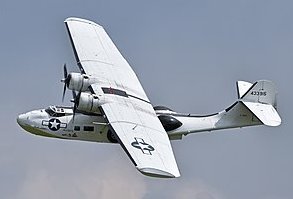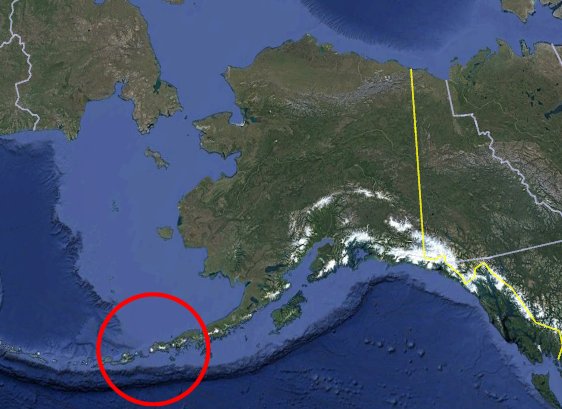ACUFO-1943-07-26-ATTU-1
In a monograph he wrote in 1971, U.S. ufologist Loren Gross told that in the book “The Thousand-Mile War“, by Brian Garfield, we learn that in the logs of the warships involved on the Aleutian theater in 1943, during the incident called the “Battle of the Pips”, on July 22, 1943, a PBY Catalina recon plane picked up seven unidentified objects moving on the surface of the ocean southwest of Attu. No visual contact was made because of thick clouds, but since the whereabouts of every American Navy ship was known, it was assumed that the objects were Japanese ships. The regional American Commander, Admiral Kinkaid, dispatched a task force to intercept the enemy. Though the PBY Catalina maintained radar contact for six hours before losing the targets, U.S. Naval units failed to arrive in time to sight and engage the apparent enemy vessels.
But Brian Garfield had also explained that as there was too much fog in the area in this incident of July 26 and 27, 1943, there was no possibility to see what caused the radar echoes. This cause was later understood as being flocks of a species of petrel birds that migrate in this area in this period every year.
| Date: | July 26-27, 1943 |
|---|---|
| Time: | ? |
| Duration: | 6 hours. |
| First known report date: | 1943 |
| Reporting delay: | Hours, weeks. |
| Country: | USA |
|---|---|
| State/Department: | Alaska |
| City or place: | Attu, Aleutian Islands |
| Number of alleged witnesses: | ? |
|---|---|
| Number of known witnesses: | ? |
| Number of named witnesses: | 0 |
| Reporting channel: | Military logs, History book. |
|---|---|
| Visibility conditions: | Fog, no visibility. |
| UFO observed: | Yes. |
| UFO arrival observed: | ? |
| UFO departure observed: | ? |
| UFO action: | Move slowly above the ocean. |
| Witnesses action: | Try to intercept with warships, fire shells. |
| Photographs: | No. |
| Sketch(s) by witness(es): | No. |
| Sketch(es) approved by witness(es): | No. |
| Witness(es) feelings: | ? |
| Witnesses interpretation: | Enemy warships. |
| Sensors: |
[ ] Visual:
[X] Airborne radar: [ ] Directional ground radar: [ ] Height finder ground radar: [ ] Photo: [ ] Film/video: [ ] EM Effects: [ ] Failures: [ ] Damages: |
|---|---|
| Hynek: | ? |
| Armed / unarmed: | ? |
| Reliability 1-3: | 3 |
| Strangeness 1-3: | 2 |
| ACUFO: | Radar echoes of birds. |
[Ref. lgs1:] LOREN GROSS:
The book: The Thousand-Mile War, by Brian Garfield, is a scholarly, factual account of World War II military action in the Aleutian theater. On page 318 author Garfield felt compelled to use the word “eerie”. Researching the logs of the warships involved, Mr. Garfield was able to reconstruct what he called the mysterious “battle of the pips” which he says: “... has yet to be explained.”
According to Garfield, on July 22, 1943, a Catalina recon plane picked up seven unidentified objects moving on the surface of the ocean southwest of Attu. No visual contact was made because of thick clouds, but since the whereabouts of every American Navy ship was known, it was assumed that the objects were Japanese ships. The regional American Commander, Admiral Kinkaid, dispatched a task force to intercept the enemy. Though the PBY maintained radar contact for six hours before losing the targets, U.S. Naval units failed to arrive in time to sight and engage the apparent enemy vessels.
[Ref. sds1:] S. DELLO STROLOGO:
A few months after the end of the war, in the waters of the Nansei Islands - Shoto and Okinawa - the commander of an aircraft carrier noticed on the radar screens “more than two hundred dots moving in the direction of the warship”; they must then have been approximately 150 kilometers away. The fighters immediately took off from the aircraft carrier but, to everyone's surprise, the “two hundred dots line” continued on their way without showing any warlike instinct.
The crew, happy with this false alarm, let themselves go with joy, but the captain remained concerned: these famous “lines of dots” could not be Japanese planes; there were really too many of them and, if it had been the Japanese, they would, without a doubt, have attacked.
[Ref. ibl1:] ILLOBRAND VON LUDWIGER:
As diplomatic consul Alberto Perego, pioneer of ufology in Italy, writes:
This is the Dawson Report (named after an American aircraft carrier commander) which summarizes a sensational event that occurred in April 1945, a few months before the end of the Pacific War against Japan, in the waters from the Nansei Shoto Islands (Okinawa). area) . In fact, on the radar of an American aircraft carrier, more than two hundred "dots" suddenly appeared, at a distance of about 100 miles, heading towards the American war unit. All available combat planes took off immediately: eight in total. It would have been suicide for the Americans to face an enemy air force in such conditions: but it was the only defense. Except that, to Commander Dawson's surprise and almost disbelief, the two hundred or so "points" flew over the American aircraft carrier and continued on their way, without attacking it. They were not observed optically with binoculars. But the radar detected them perfectly. The crew paused after escaping danger, as they correctly concluded that it could only be Japanese planes. The fact that they did not attack, however, remains a mystery. As long as they are actually Japanese devices. Which was not the case.
[Ref. rpi1:] ROBERTO PINOTTI:
This is the Dawson Report (named after an American aircraft carrier commander) which summarizes a sensational event that occurred in April 1945, a few months before the end of the Pacific War against Japan, in the waters from the Nansei Shoto Islands (Okinawa). area) . In fact, on the radar of an American aircraft carrier, more than two hundred "dots" suddenly appeared, at a distance of about 100 miles, heading towards the American war unit. All available combat planes took off immediately: eight in total. It would have been suicide for the Americans to face an enemy air force in such conditions: but it was the only defense. Except that, to Commander Dawson's surprise and almost disbelief, the two hundred or so "points" flew over the American aircraft carrier and continued on their way, without attacking it. They were not observed optically with binoculars. But the radar detected them perfectly. The crew paused after escaping danger, as they correctly concluded that it could only be Japanese planes. The fact that they did not attack, however, remains a mystery. As long as they are actually Japanese devices. Which was not the case.
The Consolidated PBY Catalina was a seaplane produced in the 1930s and 1940s. It was one of the most widely used seaplanes of World War II. Catalinas served with every branch of the United States Armed Forces and in the air forces and navies of many other nations.

|
Its range was about 2,520 miles (4,060 km, 2,190 nmi).
For its defense, it was equipped with 2 Browning 1919 7.62 mm machine guns in the nose, 1 Browning M2 12.7 mm at the front, 1 Browning 1919 7.62 mm at the rear, and 2 20 mm cannon in the nose. It could carry 900 kg of bombs and two torpedoes or anti-submarine grenades.

|
The “Battle of the Pips” aka “Battle of the Blips”, was an incident that took place on July 26 and 27, 1943, in the Aleutian islands, to prepare an amphibious assault on the island of Kiska planned for August 1943. The U.S. Navy Task Group 16.22 under command of Rear Admiral Robert M. Griffin, centered on the battleships Mississippi and Idaho, was accompanied by PBY Catalina reconnaissance seaplanes equipped with radar.
West of Kiska, a series of unknown radar contacts were made, and the order was given to open fire. Shells were fired from both battleships, but there were no hits observed.
What Loren Gross did not know is that author Brian Garfield noted that radar echoes interpretations was then somehow unreliable, and as the weather conditions around the Aleutians were quite bad, with the very poor visibility, the radar echoes were probably rafts of sooty or short-tailed shearwaters, migratory petrel that pass through the Aleutians in July every year. Garfield explained that this was confirmed by an analysis by modern Aleutian fishing-boat captains.
This explanation appeared in several historical sources, such as “Remembering the 'Forgotten War' - The Joint Operations Flaws of the Aleutian Campaign”, by Jessica D. Pisano, in JFQ 104, 1st Quarter 2022.
I note that the US Navy men at the time did not interpret the echoes as anything extraterrestrial, they interpreted the echoes as Japanese ships.
Radar echoes of birds flocks.
* = Source is available to me.
? = Source I am told about but could not get so far. Help needed.
[Ref. mmy1:] MACK MALONEY:
In the summer of 1945 a radar operator on an aircraft carrier steaming near the Nansei Shoto archipelago saw a “very large plot” suddenly appear on his radar screen. Incredibly, it looked like three hundred unidentified aircraft were heading for the carrier. Even crazier, this mass of aircraft seemed to be traveling at nearly 700 miles per hour - much faster than any airplane could go in 1945.
Navy fighters were immediately scrambled - and this is where it got really weird.
About sixty-five miles away from the carrier, the very large plot of targets began morphing into what were later described as “tentacles.” The radar screen showed these tentacles wrapping themselves around the carrier!
The two fighters were madly flying toward the target; the entire task force waited apprehensively below.
But when the fighters reached the point indicated on the radar, they found nothing. The large plot had simply disappeared.
No explanation has ever been given for the strange occurrence.
| Main author: | Patrick Gross |
|---|---|
| Contributors: | None |
| Reviewers: | None |
| Editor: | Patrick Gross |
| Version: | Create/changed by: | Date: | Description: |
|---|---|---|---|
| 0.1 | Patrick Gross | November 16, 2023 | Creation, [lgs1]. |
| 1.0 | Patrick Gross | November 16, 2023 | First published. |
| 1.1 | Patrick Gross | May 5, 2024 | Addition [sds1]. |
| 1.2 | Patrick Gross | July 27, 2024 | Additions [ibl1], [rpi1]. |